Channel News Asia (CNA) is reporting that millions of Indonesians will head to polling stations on Wednesday (27/11/24,) to elect 545 regional leaders across the world’s third-biggest democracy, an event analysts say will shape Indonesia’s political landscape over the next five years.
Indonesians will elect 37 governors, 93 mayors, and 415 regents after an official campaigning period that began on September 25 and ended on November 23.
The candidates largely hail from two political factions: President Prabowo Subianto’s 11-party Advance Indonesia Coalition or KIM Plus, and former president Megawati Soekarnoputri’s Indonesian Democratic Party of Struggle (PDI-P). A minority are independent candidates, says CNA, adding that for President Prabowo, the elections will likely determine how well his policies and programs are implemented on the ground, which ultimately translates to his re-election chances when his term ends in 2029, should he decide to seek a second term.
“If a (regional) leader comes from the opposition camp, then there is a high chance that region will not support decisions and programmes made (by the Prabowo administration) on a national level,” Hendri Satrio, a political analyst from Jakarta’s Paramadina University, told CNA.
For the PDI-P, the elections are a chance to make a comeback and stay relevant after its candidate Ganjar Pranowo, a former governor of Central Java, came in last in the presidential election with 16.5 percent of the vote, says CNA.
Prabowo won with 58.6 percent of the vote in February while former Jakarta governor Anies Baswedan was second with 24.9 percent.
The PDI-P, however, managed to secure the most votes in the legislative election held on the same day, February 14, and retain its title as the country’s largest party in parliament.
“The PDI-P will fight very hard not to lose the regional election, particularly in provinces known to be PDI-P strongholds,” Hendri said.
Source: Channel News Asia (CNA)


